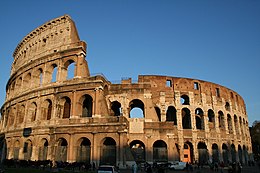
Back مدرج روماني Arabic Anfiteatro romano Spanish آمفیتئاتر رومی Persian Amphithéâtre romain French Anfiteatro romano Italian ರೋಮನ್ ಆಂಫಿಥಿಯೇಟರ್ Kannada 로마 원형극장 Korean Rimski amfiteater Slovenian

Roman amphitheatres are theatres — large, circular or oval open-air venues with tiered seating — built by the ancient Romans. They were used for events such as gladiator combats, venationes (animal slayings) and executions. About 230 Roman amphitheatres have been found across the area of the Roman Empire. Early amphitheatres date from the Republican period,[1] though they became more monumental during the Imperial era.[2]
Amphitheatres are distinguished from circuses and hippodromes, which were usually rectangular and built mainly for racing events, and stadia, built for athletics, but several of these terms have at times been used for one and the same venue. The word amphitheatrum means "theatre all around". Thus, an amphitheatre is distinguished from the traditional semicircular Roman theatres by being circular or oval in shape.[3]
- ^ Welch, Katherine E. (2007). The Roman amphitheatre: from its origins to the Colosseum. Cambridge University Press. p. 9. ISBN 978-0-521-80944-3.
- ^ Bomgardner, 61.
- ^ Bomgardner, 37.